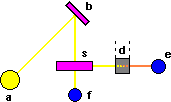
UV Detector
UV detectors (strictly speaking, UV/VIS detectors) quantify absorption of UV/VIS-active substances in the range from 190 to 380nm (UV range) and 380 to 900nm (VIS range). UV detectors provide high sensitivity and a large linearity range. UV detectors are relatively independent from temperature fluctuations; they can be used for gradient elution (%-gradient).
Functionality
A grating (b) disperses the light that is emitted from a light source (a) in a discontinued spectrum. Simultaneously, the grating serves as a filter and directs only the wavelengths required for detection to a beam splitter (s). A portion of the beam is directed through the flow cell (d) onto a photodiode (e), the other part is used as a reference (f).

Theory
Depending on the absorptivity (e) of the substance, the light beam is more or less attenuated when traversing the flow cell. For the absorption (E), the following is true:
E = e c d
As the length of the cell (d) is constant and the absorptivity (e) depends only on the substance itself or the absorbed wavelength, there is a direct connection between the substance concentration (c) and the absorption (E). The absorption measured in AU ("absorbance unit") is thus proportional to the number of particles in the beam path ("Lambert-Beer absorption law").
Wavelength Calibration
The wavelength is calibrated automatically after a certain command (e.g., Lamp = On or Connect) (detector calibration). In addition, most detectors have a command that checks the currently valid wavelength calibration and logs the result to the Audit Trail (for details, refer to the detector's commands list in the Device Control section.
Calibration is possible only when certain conditions are met:
During calibration, the baseline must be sufficiently stable. This may not be the case, for example, if the solvent composition has been modified or if there are gas bubbles in the solvent.
The solvent in the cell must not be fully absorbing in the wavelength range that is calibrated. This will be the case, for example, if the cell is filled with 96% hexane / 4 % ethyl acetate.
Before calibration, make sure that the deuterium lamp is already warm because its spectrum changes a lot during the first minutes after turning on the lamp.
If these conditions are not met, the process will be interrupted with the corresponding error message. When the problem is solved, repeat the calibration by selecting Disconnect and Connect.
Detector Calibration
The detector is calibrated via a holmium oxide filter that is installed in the beam path of the deuterium lamp. The maxima are determined from the resulting transmission spectrum and compared to the holmium oxide values stated in the literature. If a difference is detected for this maximum between the measured and the known value, this maximum and the two adjacent maxima are interpolated to correct the wavelength allocation of the affected photodiodes. Wavelength calibration can take up to two minutes. During this time, data acquisition will not be possible.
Also, see Photodiode Array Detector.